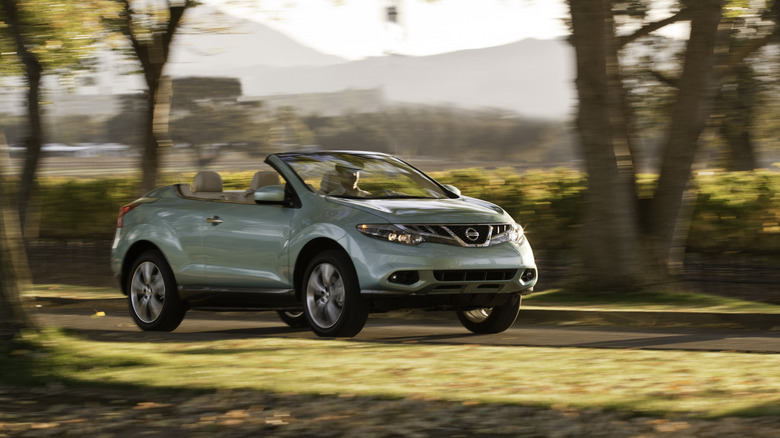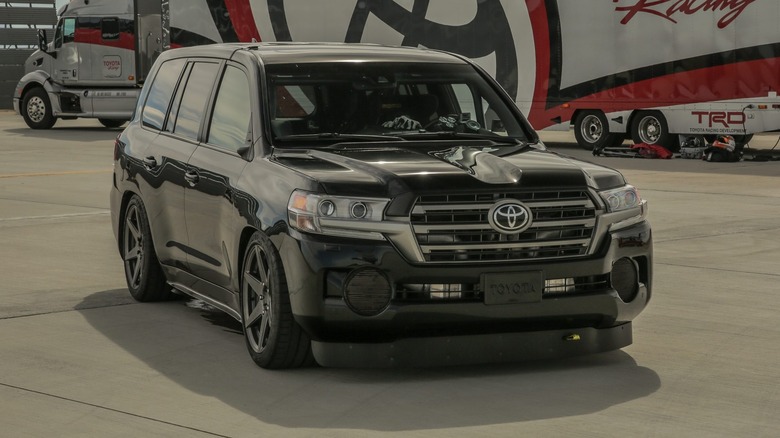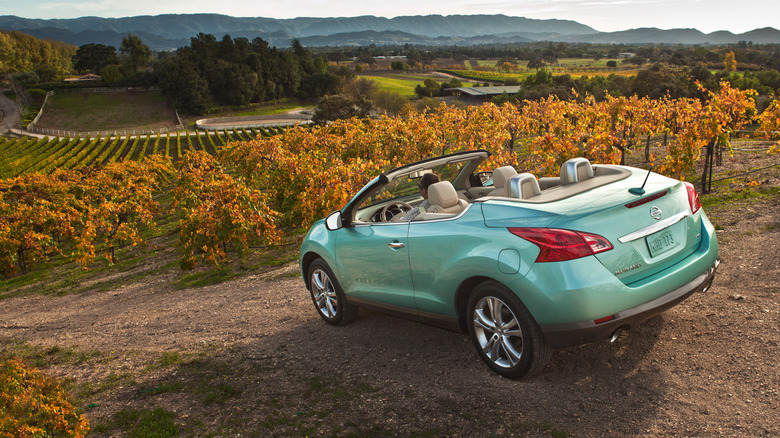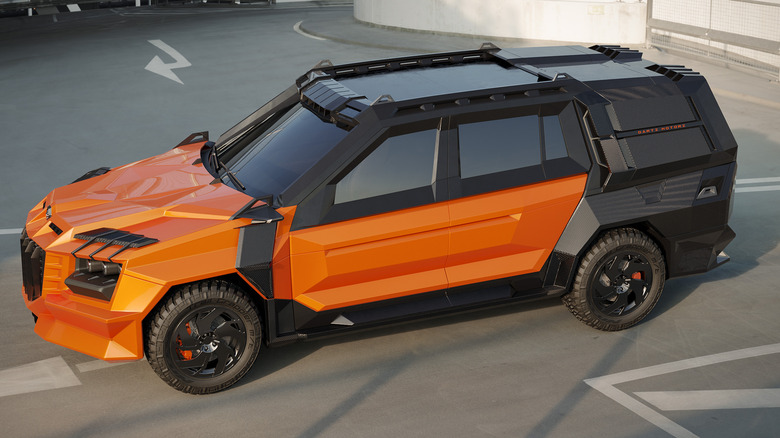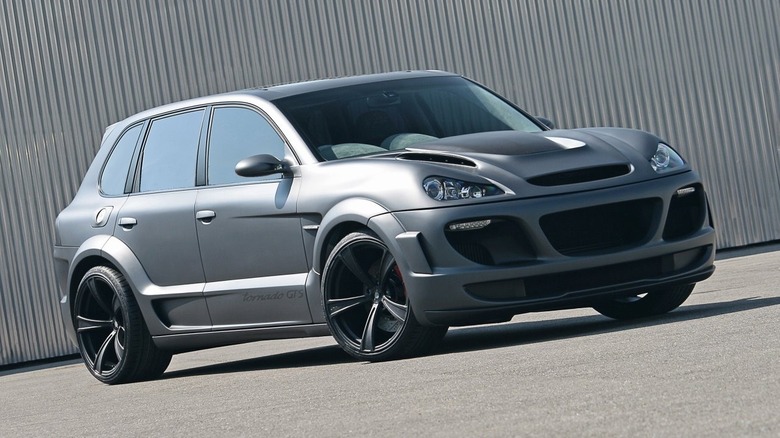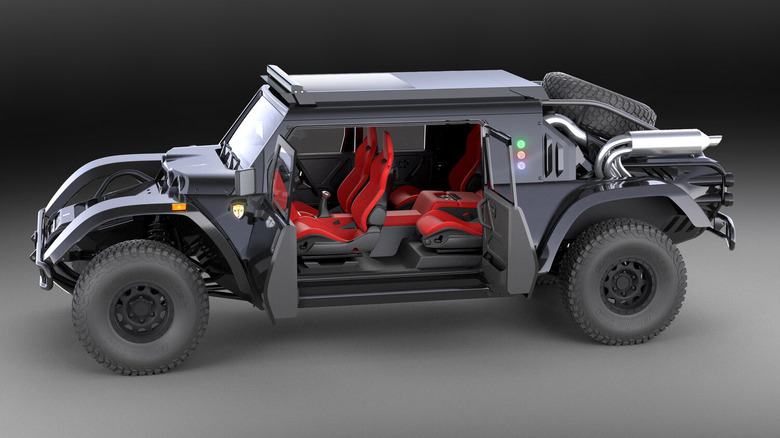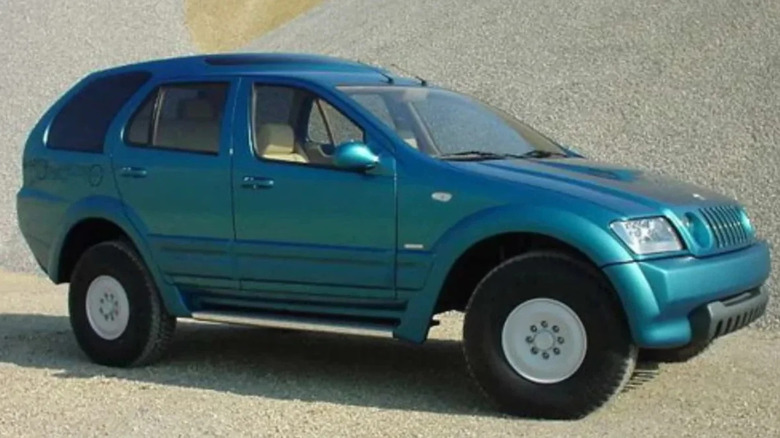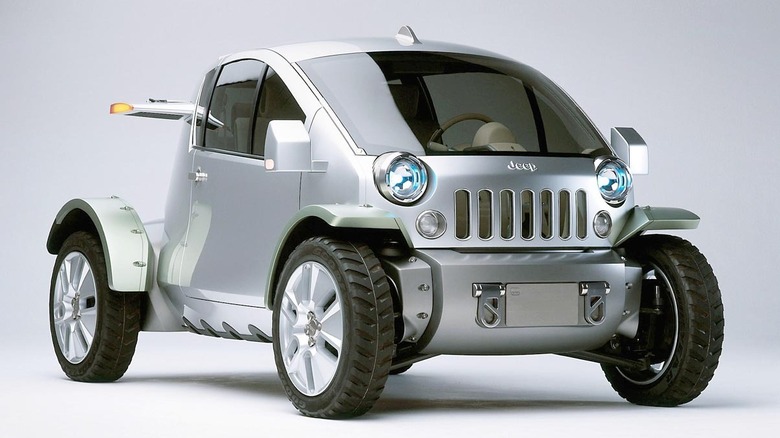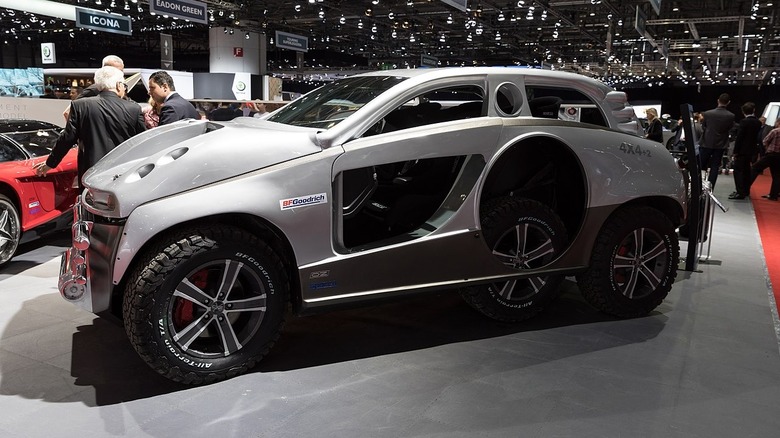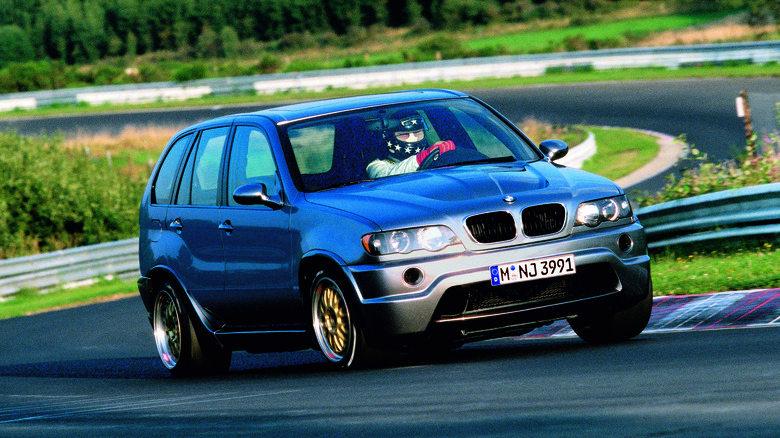12 Weirdest SUVs Ever Made
SUVs are now one of the most popular segments of the auto industry, with more choices than ever for consumers looking to buy one. However, with the rise of crossovers and SUVs stifling demand for other body styles, there have been some accusations that SUV mania is making modern cars all look the same. There might be an element of truth to that, at least in terms of the most popular models, but not every SUV would blend into traffic on a busy freeway. Some are quite the opposite — in fact, they're so weird that you'd be forced to stop and stare no matter where you were.
From podgy convertible cruisers to a Baja buggy designed to pick up the kids from school, there are lots of odd SUVs that made it to production, and some of the ones that didn't are even weirder. Not every weird SUV is "bad," far from it — sometimes, pushing the boundaries of automotive design yields results that are very cool indeed, even if they require a double take the first time you see them. For every success story, though, there's another SUV that'll leave you wondering how anyone thought it was a good idea to build it in the first place.
Toyota Land Speed Cruiser
The Toyota Land Cruiser enjoys a rock-solid reputation for being one of the most reliable, capable all-terrain SUVs on the planet, but it's hardly what you'd call fast. In 2016, Toyota decided to change that by taking a standard U.S.-spec Land Cruiser and extensively modifying it, rebuilding its stock 5.7L V8 engine to produce an unbelievable 2,000 horsepower. The resulting one-off creation was christened the "Land Speed Cruiser," and it currently holds the title for the world's fastest SUV.
Upgrading the engine was only part of the story. In order to make the boxy SUV aerodynamic enough to achieve such a high speed, the frame had to be reworked to accommodate lower suspension and wide Michelin Pilot Super Sport tires. The record was achieved at Mojave Air and Space Port in 2017, the year after the car was first unveiled at SEMA. So, as weird as it might seem, the official fastest SUV in the world is not a Bentley, Lamborghini, or Ferrari, but rather a humble Toyota Land Cruiser, albeit a highly modified one.
Nissan Murano CrossCabriolet
In the early 2010s, SUVs were proving to be very popular with buyers, and convertibles were also seeing strong demand. Nissan, for some reason, decided to combine the two, unveiling the Murano CrossCabriolet to a largely bewildered public. SlashGear drove the car at launch and found it was more of a weird novelty than a feasible daily driver, despite Nissan's claims of "bridging the divide" between the appeal of a convertible and the practicalities of everyday journeys. It was decent enough to drive at lower speeds, but take it out of town with its soft suspension meant that there was plenty of body roll.
Likewise, the steering felt vague and the reviewer wasn't keen on the CrossCabriolet's awkward proportions, with the low roofline emphasizing the bulky nature of the rest of the car. Looking back over 10 years after our initial review, it's fair to say that its design hasn't gotten any more palatable over time. The Murano CrossCabriolet was sold between 2011 and 2014, and eventually, low sales forced Nissan to give it the ax. It might have been the first, but it wasn't the last small SUV to get the chop-top treatment, as a few years later, Land Rover unveiled its own convertible version of the Evoque.
Dartz Prombron Black Alligator MMXX Black Tiger Lunar Year Edition
You only have to look at the outrageously over-the-top name of the latest SUV from boutique Latvian carmaker Dartz to realize that this is no ordinary luxury car. It's built on the platform of the Mercedes-Maybach GLS 600, but it features bulletproof glass and bodywork, and up to 850 horsepower, a leap of 300 horses over the donor car's output. As its name suggests, the car was built to commemorate the Chinese Year of the Tiger, with the bright orange paintwork signifying wealth and celebration. You'd certainly need significant wealth to buy one, although Dartz doesn't disclose exactly how much a Black Alligator will cost until you commission one. Earlier versions of the SUV were said to cost somewhere north of $1 million.
Apart from its outlandish looks and over-the-top armoring, the Dartz's other claim to fame is that the interior is made out of very weird materials. This includes the skins of "alligators, sharks and stingrays," among other animals, although, unlike the brand's previous SUV, there's no option to furnish your car in leather made from whale genitalia this time (yes, really). There are also electric shock generators built into the doors to guard against potential break-ins, and you can even order an "anti-paparazzi pack" featuring sirens and blinding laser lights to supposedly stop any unwanted photographers while you're driving about in your bright orange luxury armored truck.
Gemballa Tornado 750 GTS
German tuner Gemballa specializes in producing head-turning low-volume cars for owners who can't bear the thought of having the same supercar as anyone else, but one of its longest-running models is actually an SUV. The Gemballa Tornado is still available to order from the carmaker today, but it's the first-generation Tornado 750 GTS that arguably takes the crown for the weirdest iteration of the line. The car is based on a Porsche Cayenne, but packs an upgraded engine making 750 horsepower and a body kit that, to put it nicely, is an acquired taste.
It looks like something a cartoon villain would drive, with overly sculpted vents and scoops that distort the Cayenne's face into a weird, angry caricature of itself. Inside, the usual German tuner stereotypes have been applied — lots of lavish furnishings, but with much of the dash and gauges visibly carried over from the donor car. A limited run of 50 production cars was originally planned to be built with a starting price of €400,000 (around $586,000 adjusting for inflation). It's unknown how many of those originally planned units Gemballa actually managed to sell.
Scuderia Cameron Glickenhaus Boot
The racing outfit helmed by Jim Glickenhaus and his wife Meg Cameron might be small, but it's responsible for churning out some of the most interesting American race cars in recent years. That includes the Baja-ready SCG Boot, which is a modern reinterpretation of Steve McQueen's classic Baja Boot racer. Incidentally, Glickenhaus actually owns one of the two original Baja Boot cars, and it was while he was driving it around New York that he had the idea to create a new version.
The resulting off-road SUV is undoubtedly weird, but it looks like an absolute blast to drive. With a 650 horsepower V8 engine mounted at the rear of the car, 14 inches of ground clearance, and 18 inches of suspension travel, there isn't much that the Boot can't conquer. To prove its capabilities, Glickenhaus and his team drove a Boot from a workshop in California down to the starting line of the Baja 1000 in 2019, won their class in the race, then drove it straight back home again. The Boot is available in either two-door or four-door form, and the team has even reportedly developed a car seat for the rear, just in case you need to go pick the kids up when you're done leaping over the dunes.
Coggiola T-Rex
Most car enthusiasts are well aware of the gargantuan Hummer H1, but few will remember its unlikely Italian counterpart, the Coggiola T-Rex. The T-Rex was built on an H1 chassis and carried over its 6.5L turbodiesel V8 engine, but sported an entirely new body shell and a luxurious interior. Built by Turin-based coachbuilder Coggiola, the car was the brainchild of Sergio Coggiola, who formerly worked at Ghia. With its Jeep-like grille and bulbous rear end, it wasn't the most attractive-looking SUV on the market, in fact, it looked more like an oversized Jeep Cherokee rip-off than anything an exclusive coachbuilder would offer.
It was also extremely heavy, weighing in at over 7,000 lb. As a result, it took a full 18 seconds to crawl from 0-60 mph and topped out at just 83 mph. For reference, even the Cherokee of the era could reach 60 mph in under 10 seconds. Coggiola planned to sell 50 units of the car for more than half a million dollars apiece, but in the end, only one example was ever built. Sergio Coggiola died a few years after the car was unveiled, and the T-Rex project was canceled after his passing.
Jeep Treo
Unveiled in 2003, the Jeep Treo was the brand's vision for the future, where buyers wanted alternative-fuel cars in small yet capable packages. Occupants sat in an unusual 2+1 seating configuration, with one seat able to fold down to provide extra room for large cargo. The car featured drive-by-wire controls and a modular layout, with the radio, GPS, and air-con all controlled via a removable touchscreen.
However, the weirdest bit about the Treo has to be its exterior design. With a short, compact frame and wheels sticking out of the sides, it took the idea of a subcompact SUV to new extremes. Reports at the time suggested that a production version of the Treo was very likely to hit showrooms within a few years of the concept's unveiling, with executives planning for the car to have a hybrid gas/electric powertrain. It's not known why the project was canceled, but it's possible that it was eventually decided that there simply wasn't enough of a market for such a tiny Jeep SUV.
Isuzu VehiCross
Although its design might leave you scratching your head, the Isuzu VehiCross was a surprisingly capable off-roader. Much of its internals were borrowed from the Isuzu Trooper, and the car used a traditional body-on-frame construction like its mass-market sibling. A race version of the VehiCross entered the Paris-Dakar Rally in 1998 and won its class, and it won again at the Australian Safari Rally the following year. A good racing SUV then, but a very weird looking one.
From the strange embedded spare wheel that's only accessible from inside the rear tailgate, to the prominent plastic paneling that surrounds the car, it seems like Isuzu's designers went out of their way to make the car look as odd as possible. The VehiCross is also inexplicably heavy for its size, weighing around 1,000 pounds more than a Toyota RAV4 despite the two SUVs having similar dimensions. Even so, it remained one of the sportiest cars in its class at the time, remaining composed and eager both on and off the road. Its looks ended up being too divisive for the VehiCross to see mainstream sales success, and Isuzu only shipped around 6,000 units of the car before axing it for good.
Sbarro 4x4+2
Although it might not look like it, the Sbarro 4x4+2 started off as a Porsche Cayenne. It was then redesigned by the students at Franco Sbarro's Espera Sbarro school, before debuting in its final form at the 2018 Geneva Motor Show. Any trace of the original Cayenne's lines are long gone, replaced with a baffling design that looks like it was deliberately created to be as ugly as humanly possible. It was reportedly built as a six-wheeled off-road racer, with a stripped-out interior that aimed to keep weight to a minimum.
That makes it all the odder that Sbarro's design team chose to include an extra pair of wheels that don't quite touch the ground. The designer shared no information about the purpose of these wheels, and at first glance, they appear to be an unnecessary (and weighty) extra. Even odder is the circular cut-out that displays this mystery pair of wheels, which doesn't seem to have any function other than to add to the weird looks. Short of tracking down the original team of students who designed the car, it seems like there's no way to find out the reasoning behind the design of the 4x4+2, as it's made no further public appearances since the show in Geneva.
[Featured image by Matti Blume via Wikimedia Commons | Cropped and scaled | CC BY-SA 4.0]
Suzuki X-90
The '90s saw carmakers debut all sorts of odd creations in an attempt to fill niches no one had even thought of before, but many of those initial prototypes never made it to production. Suzuki, however, had no such qualms putting its X-90 compact SUV into dealerships, although the reception to it was far from stellar. In fact, it's even picked up a reputation as being one of the worst cars of its era. This is largely down to the fact that it tried to do too many things at once: It was simultaneously a two-seater convertible and a small SUV, yet it wasn't very good at being either of the two.
Its rough ride meant that it wasn't great for street driving, but it wasn't capable off-road either. The T-Top roof was removable, but when the roof was stored in the trunk, there was no room left to actually carry any luggage. It was also double the price of its predecessor, the Samurai, putting it out of reach of many of Suzuki's previous customers. It wasn't even quick, taking 10.8 seconds to go from 0 to 60 mph and topping out at 94 mph. Unsurprisingly, the X-90 never sold well and ended up being axed just two years after it was launched in 1995.
Rainbow Sheikh's Dhabiyan
Sheikh Hamad bin Hamdan Al Nahyan, also known as the "Rainbow Sheikh," has a penchant for huge vehicles. His vast car collection includes a Mercedes-Benz 350SEL with monster truck wheels, the largest operational Jeep replica in existence, and a scaled-up classic Dodge truck that's so huge a regular Dodge truck can park underneath it. His 200-car garage also features the world's largest SUV, which is based on an Oshkosh M1075 military truck but also borrows parts from a Dodge Dart, Jeep Wrangler, and a Ford Super Duty.
All the key mechanical and structural parts are kept from the donor Oshkosh, including a 600-horsepower engine. The majority of a Jeep Wrangler's body is mounted on the rear to form the driver's cabin, with a ladder mounted to the back of the truck so that the Sheikh can climb up into it. The car is kept at the Sheikh's auto museum in Abu Dhabi, so it doesn't get much use, but it is nonetheless fully functional and can climb even the steepest sand dunes with ease. You'd hope so, given that this is essentially a military tank transporter in chrome-plated civilian guise.
BMW X5 Le Mans
The first-generation BMW X5 helped set the blueprint for today's SUVs, as it was one of the first to focus on purely road handling and manners rather than retain any off-road capability. It was still a long way from what would today be considered a super-SUV — apart from one X5 built by BMW's skunkworks, that is. The X5 Le Mans might not look vastly different from a regular SUV at first glance, but look under the hood and you'll find the same racing V12 engine that powered the McLaren F1.
In the X5 Le Mans, that engine was tuned to produce around 700 horsepower, around 120 horsepower more than the configuration used in the Le Mans-winning 1999 V12 LMR race car. It took the SUV to a top speed of around 193 mph, with 0-62 mph achieved in 4.7 seconds. It was built as a technical demonstration to prove the performance potential of the X5 chassis, yet even today, a top-spec 2024 X5M Competition doesn't pack as much horsepower as the X5 Le Mans. A true one-off, a boxy SUV with a racing V12 might have been a weird combination, but one that many would certainly jump at the chance to get behind the wheel of.
